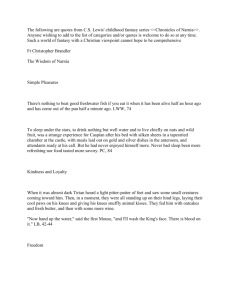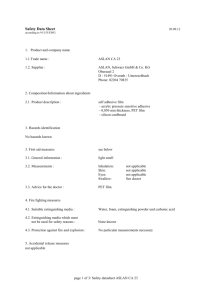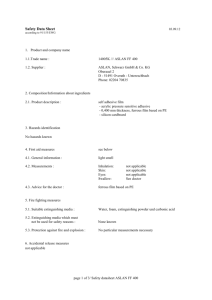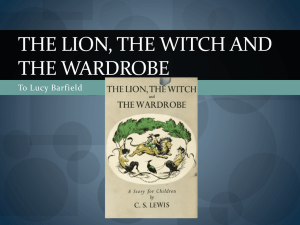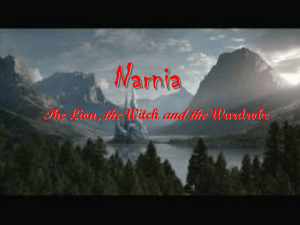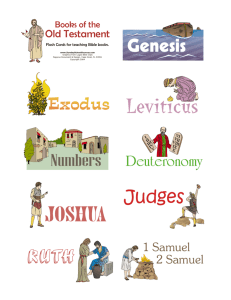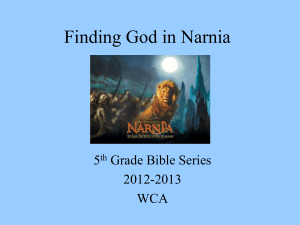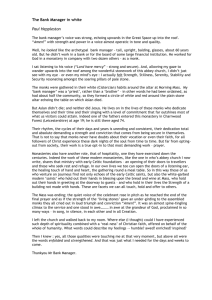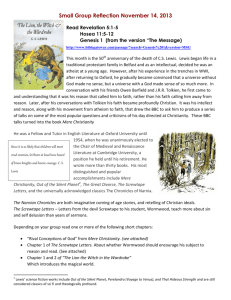Deeper magic before the dawn of time: an analysis of the hidden
advertisement
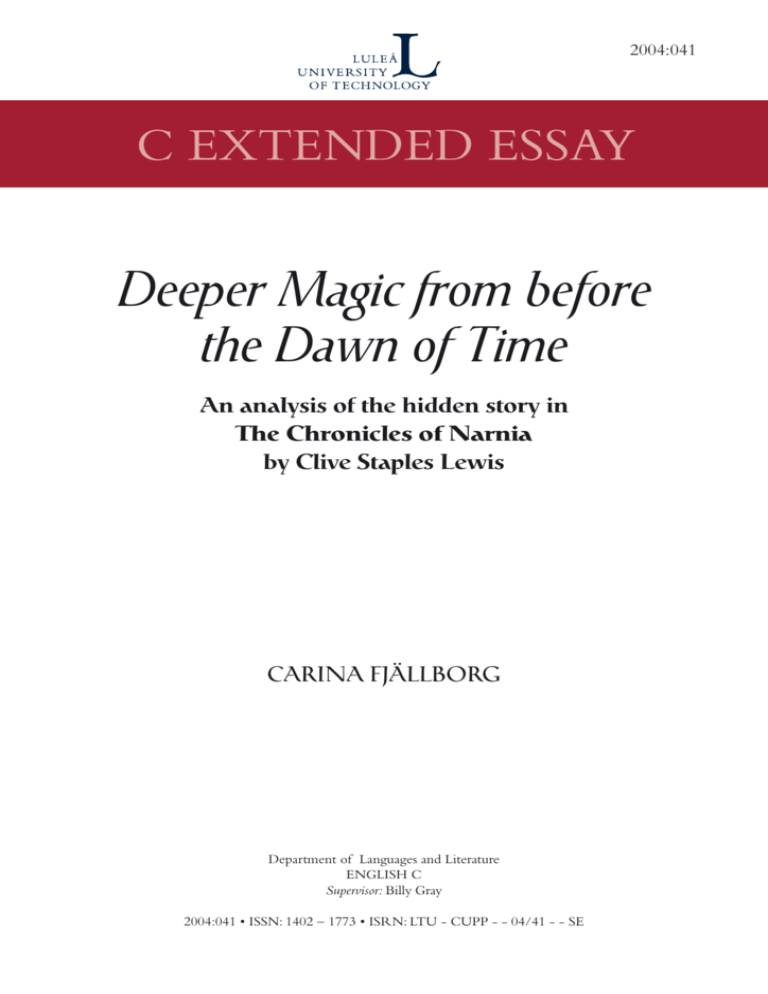
2004:041 C EXTENDED ESSAY Deeper Magic from before the Dawn of Time An analysis of the hidden story in The Chronicles of Narnia by Clive Staples Lewis CARINA FJÄLLBORG Department of Languages and Literature ENGLISH C Supervisor: Billy Gray 2004:041 • ISSN: 1402 – 1773 • ISRN: LTU - CUPP - - 04/41 - - SE Deeper Magic from before the Dawn of Time An analysis of the hidden story in The Chronicles of Narnia By Clive Staples Lewis Extended C-Essay Carina Fjällborg 600611-8985 Fågelvägen 21 981 41 Kiruna 0980/18018 CONTENTS Introduction 1 List of abbreviations 4 Aslan as a Christ figure 5 Aslan’s sacrifice 10 Salvation 15 Conclusion 19 List of Works Cited 21 Introduction Clive Staples Lewis’ seven magical books about Narnia have fascinated children (both young and old) all over the world. The first, The Lion, the Witch and the Wardrobe, was published in 1950 and thereafter one book a year was released until 1956: Prince Caspian (1951), The Voyage of the Dawn Treader (1952), The Silver Chair (1953), The Horse and His Boy (1954), The Magician’s Nephew (1955) and The Last Battle (1956). The Last Battle won the Carnegie Medal for the best children’s book of the year.1 In the last fifty years the books have sold more than 100 million copies and been translated into some 30 languages.2 Lewis was in his late forties when he began writing The Lion, the Witch and the Wardrobe(LWW). At that time he was a highly respected professor in Oxford and a famous writer, but he had carried the picture in him of a faun carrying an umbrella and parcels in a snowy wood since he was about sixteen. In 1948 he decided to write a story about it and once he had begun writing “Aslan came bounding in.” 3 Lewis explained the inspiration for his books as follows: ‘pictures come into my head and I write stories about them’. One such picture was of the faun; another was of a snow queen on a sledge; and another was of ‘a magnificent lion’. Before writing Aslan into the story, Lewis had dreamt of lions for several nights. When writing LWW Lewis did not think there would be any more books about the land of Narnia, but once the lion had entered his imagination, he pulled the other stories in after him4. In a letter to a young reader Lewis wrote: “I’m so thankful that you realized the ‘hidden story’ in the Narnian books. It is odd, children nearly always do, grown-ups hardly ever.”5 1 George Sayer, Jack, en biografi om C S Lewis, (1988; Örebro: Libris, 1999). 18 http://www.factmonster.com/spot/narnia-lookback.html 3 Brian Sibley, The Land of Narnia, (London: Collins, 1989) 21-22 4 Sibley, 91 5 Sibley, 89 2 1 This essay will deal with that ‘hidden story’. In the last chapter of The voyage of the Dawn Treader (VDT) the children meet a lamb that changes into the lion Aslan. He reveals that he is in our world as well as in Narnia: “But there I have another name. You must learn to know me by that name. This is the very reason why you were brought into Narnia, that by knowing me here for a little, you may know me better there...”6 Lewis became a Christian when he was in his mid-thirties and he testifies about his conversion in his autobiography Surprised by Joy, which was published in 1955, the same year as The Magician’s Nephew7. C S Lewis is considered to be the most important Christian writer of the 20th century,8 and it could be claimed that The Chronicles of Narnia undeniably expresses the author’s Christian faith. The lion Aslan comes straight from the heart of Lewis’ personal relationship with Jesus Christ. However, it was not Lewis’ intentions to write “encoded depictions of Christian truth, or moral lessons sugarcoated to appeal to children”.9 In 1954, he explained the Aslan-Christ parallel to some students in Maryland: “I did not say to myself ‘Let us represent Jesus as He really is in our world by a Lion in Narnia’; I said ‘Let us suppose that there were land like Narnia and that the Son of God, as he became a Man in our world, became a Lion there, and then imagine what would happen”.10 The aim of this work is to show similarities between the lion Aslan and Jesus Christ as he is depicted in the Bible, and consequently to examine the concept of sacrifice and salvation in The Chronicles. 6 Sibley, 91 C S Lewis, Surprised by Joy, (Glasgow, William Collins Sons & Co Ltd, 1981) 8 http://cslewis.drzeus.net/bio/bio.html 9 http://cslewis.drzeus.net/papers/originsofnarnia.html 10 http://cslewis.drzeus.net/papers/lionwitchallegory.html 7 2 In this essay all seven volumes of The Chronicles are examined and compared with three different versions of the Bible; in addition a number of secondary texts and articles are referred to. The Bible quotations are selected to emphasise the argument and make it easier for the reader to follow the line of reasoning. The essay is divided into three chapters; the first chapter deals with Aslan as a Christ figure, the second with the concept of sacrifice and the third with the concept of salvation. 3 List of abbreviations 1 Kings 1 Book of Kings Ex Exodus Heb Hebrews Isa Isaiah Lev Leviticus PC Prince Caspian Rev Revelations Rom Romans Chronicles The Chronicles of Narnia John The gospel of John Luke The gospel of Luke Mark The gospel of Mark Matt The gospel of Matthew HHB The Horse and his Boy LB The Last Battle LWW The Lion, the Witch and the Wardrobe MN The Magician’s Nephew SC The Silver Chair VDT The Voyage of the Dawn Treader 1 Tim 1 Timothy 4 1. Aslan as a Christ figure “They say Aslan is on the move.”11 This is the first reference to Aslan in LWW. Long before he actually enters the scene, Peter, Susan, Edmund and Lucy hear about the forthcoming Lion, who is going to deliver Narnia from the evil White Witch. The beavers also tell them about the prophecy in an old rhyme: Wrong will be right, when Aslan comes in sight At the sound of his roar, sorrows will be no more When he bares his teeth, winter meets its death And when he shakes his mane, we shall have spring again.12 Similar expectations are made of the Messiah in the Old Testament. In the book of Isaiah the prophet talks about the birth of the Prince of Peace in chapter 9:1-7: For unto us a Child is born. Unto us a Son is given: And the government will be upon His shoulder. And his name will be called Wonderful, Counselor, Mighty God, Everlasting Father, Prince of Peace.13 When Lucy asks the beavers about Aslan they tell her that he is the King of Beasts and the son of the Emperor-beyond the Sea (Chronicles ,146), which is comparable with the description of Jesus as the “king of kings” (Rev 19:16) and the Son of God (Matt 14:33).14 The power of Aslan’s name, especially when used in prayer, is highlighted. In VDT, Caspian undertakes the voyage into the darkness surrounding the Dark Island only after invoking the name of Aslan and it is in answer to Lucy’s prayer to Aslan that the albatross comes to lead 11 C S Lewis, The Chronicles of Narnia, 1950,1951,1952,1953,1954,1955,1956 (New York: Harper Collins Publishers,2001), 141 12 Lewis,The Chronicles, 146 13 The Holy Bible, New King James Version, (Nashville: Thomas Nelson P, 1982),465 14 NKJV, 660 and 833 5 the Dawn Treader out of this darkness. In Rom 10:13 Paul writes;”For everyone who calls upon the name of the Lord [invoking Him as Lord] will be saved.”15 Subsequently in VDT Aslan turns up transformed into a lamb and reveals to the children that he has another name in our world: “But there I have another name. You must learn to know me by that name. This was the very reason why you were brought to Narnia, that by knowing me here for a little, you may know me better there.”16 That this name is undeniably Jesus Christ is proved by the reply C S Lewis gave a young girl who wrote a letter to Lewis asking what name Aslan used in our world: “As to Aslan’s other name, well I want you to guess. Has there ever been anyone in this world who (1) Arrived at the same time as Father Christmas? (2) Said he was the Son of the Great Emperor? (3) Gave himself up for someone else’s fault to be jeered At and killed by wicked people? (4) Came to life again? (5) Is sometimes spoken of as a lamb?”17 Jesus is referred to as ‘a lamb’ in at least two different sections in the Bible. The first instance is found in Isaiah 53:7: He was oppressed and he was afflicted, Yet He opened not His mouth; He was led as a lamb to the slaughter And as a sheep before its shearers is silent, So He opened not his mouth. 18 15 The Amplified Bible, New testament, (Michigan, Zondervan Bible Publishers,1987) 264 Lewis, The Chronicles, 541 17 Sibley, 91 18 NKJV,497 16 6 The second one is from John 1:29: “…Behold! The Lamb of God who takes away the sin of the world.” 19 The true beasthood of Aslan is made clear in The Horse and His Boy (HHB). When Aravis asks Bree why he always swears “By the Lion and By the Lion’s Mane” he explains that everybody in Narnia swears by Aslan’s name, but that Aslan is not a lion at all but fierce or strong as a lion. In revealing himself, Aslan urges Bree to touch him: “I am a true Beast”20 Likewise the true manhood of Christ is described in the gospel of John; “And the Word (Christ) became flesh (human, incarnate) and tabernacled (fixed His tent of flesh, lived awhile) among us: and we [actually] saw His glory (His honor, His majesty), such glory as an only begotten son receives from his father, full of grace (favor, loving-kindness) and truth.”21 Further, in the gospel of John, Jesus says to Thomas: “Reach your finger here, and look at My hands; and reach your hand here, and put it into My side. Do not be unbelieving, but believing.” 22 It has been argued that Aslan becomes more out of focus after LWW and it is true that he is not physically present to the same extent in the other books in the series. The Lion Aslan is first and foremost portrayed as a Christ figure in The Chronicles, but he also appears as the other two members of the Trinity, namely the Father and the Holy Spirit. In Prince Caspian (PC), VDT and in HHB Aslan is depicted as the omnipotent comforter and protector. In PC the children are trying to find Prince Caspian, led by the red dwarf Trumpkin. They are going in the wrong direction when Lucy sees a glimpse of Aslan in the opposite direction to their chosen track (Chronicles, 373). The others refuse to believe that she has seen what they have 19 NKJV, 714 Lewis, The Chronicles, 298 21 The Amplified Bible, 148 22 NKJV, John 20:27, 732 20 7 not. Later when Aslan reveals himself to them, they are ashamed of their lack of faith, but Aslan just breathes on them: ”You have listened to fears, child,’ said Aslan. ‘Come, let me breathe on you. Forget them. Are you brave again?”(Chronicles, 386). The Silver Chair (SC) deals to a great extent with facing fears, and part of Jill’s problem in continually forgetting the signs given by Aslan is fear. (Chronicles, 603) In Aslan’s country there is no fear. In MN he says to the newly created Talking Beasts: “Laugh and fear not, creatures” (Chronicles, 72). Aslan tells Lucy not to fear the river of death, which lies across the way to his own country, because he is ‘the great Bridge Builder’. In Matthew 8:24-26 Jesus and his disciples are in a boat when a violent storm arises on the sea, so that the boat is being covered by the waves. The disciples panic and awaken Jesus, begging Him to rescue them. Jesus replies to their fear: “Why are you timid and afraid, O you of little faith.”23 In Mark 5:21-36 Jairus, one of the rulers of the synagogue, comes up to Jesus and begs Him to come and lay His hands on his daughter who is dying. In approaching the ruler’s house, people come and tell them that the girl has died. Jesus then turns to the ruler saying: ”Do not be seized with alarm and struck with fear; only keep on believing.”24 In VDT Lucy is asked by the Dufflepuds to find the magic book and read the spell that removes their invisibility. When she has read the spell, Aslan turns up in the doorway: For what stood in the doorway was Aslan himself, the Lion, the highest of all High Kings… ‘Oh, Aslan, said she, it was kind of you to come. ‘I have been here all the time,’ said he, ‘but you have just made me visible.”25 This passage is comparable with Jesus’ last words in the gospel of Matthew: “...and lo, I am with you always, even to the end of the age”(NKJV, 672). Though Aslan is not always visible for the children, he is always there, protecting and guiding them. In the following chapter an 23 The Amplified Bible, 13 The Amplified Bible, 63 25 Lewis, The Chronicles, 498 24 8 albatross turns up above the ship, lighting it up as by searchlight and leading the ship out of the darkness surrounding The Dark Islands. When circling the mast, Lucy had heard the voice of Aslan whispering: ‘Courage, dear heart,’ (Chronicles,511). In these passages Aslan is portrayed as the third person in the Trinity, The Holy Spirit, who is described in John 15:26 as “the Comforter (Counsellor, Helper, Advocate, Intercessor, Strengthener, Standby)” (The Amplified Bible, 182). In HHB Shasta and Aravis believe that they are chased in the desert by two lions, but Aslan subsequently reveals that there was only one and that he did it to make the horses Bree and Hwin run faster to escape their Calormene pursuers.26 Later in HHB, Shasta is followed by something when he, alone in the mist, tries to find his way to Narnia. This something, who turns out to be Aslan, reveals his identity when the boy finally finds the courage to ask who he is: ‘Myself’, said the voice very deep and low so that the earth shook: and again, ‘Myself’, loud and clear and gay: and then the third time ‘Myself’, whispered so softly you could hardly hear it, and yet it seemed to come from all round you as if the leaves rustled with it.27 This passage is reminiscent of Moses asking God what to answer the children of Israel when they ask ‘What is His name?’ and God answered: ‘I AM WHO I AM’ (Ex 3:13, NKJV). However it is also reminiscent of a passage in 1 Kings 19:11-12 where God spoke to Elijah in a wind, in an earthquake, in a fire and finally in a still, small voice. 26 27 Lewis, The Chronicles, 271 Lewis, The Chronicles, 281 9 2. Aslan’s sacrifice Lewis uses a central Christian theme in The Chronicles of Narnia, namely the doctrine of redemption.28 As early as the creation scene in The Magician’s Nephew (MN), Aslan tells the Beasts about the evil that has entered Narnia: “…before the new, clean world I gave you is seven hours old, a force of evil has already entered it; waked and brought hither by this son of Adam.” Thereafter he predicts his own death: “Evil will come of that evil, but it is still a long way off, and I will see to it that the worst falls upon myself.”29 In Isaiah 53:4-5, the prophet foretells the redemptive death of Christ: Surely he has borne our griefs (sic!) And carried our sorrows; Yet we esteemed him stricken, Smitten by God and afflicted. But he was wounded for our iniquities; Upon him was the chastisement that made us whole, And with his stripes we are healed.30 Jesus also informs his disciples about His forthcoming death in the gospels (Matt. 16:21; Mark 8:31; Luke 18:31-33; John 12:23-33). The redemptive work of Aslan in LWW is at the heart of The Chronicles. When Edmund betrays Aslan –as Judas betrayed Jesus - and his siblings for some Turkish Delights and the promise of becoming a prince and the future ruler of Narnia (Chronicles, 126), the White Witch knows that she has the right to claim Edmund’s life: “You at least know the Magic which the Emperor put into Narnia at the very beginning. You know that every traitor belongs to me as my lawful prey and that for every treachery I have a right to kill.” 28 David Öquist, The Portrayal of Christ in The Chronicles of Narnia, Luleå: Luleå U of T, 2000 Lewis, The Chronicles, 80 30 KJV, 496 29 10 ”He knows the Deep Magic better than that. He knows that unless I have blood as the Law says, all Narnia will be overturned and perish in fire and water.”31 The Deep Magic is the effect of justice in a created world and the words of the Deep Magic are inscribed in the Stone Table and on the sceptre of the Emperor-beyond-the-Sea, which establishes the basis for the legitimacy of its claims. The Witch understands it only to the extent that she knows that a traitor’s blood belongs to her. Aslan’s knowledge of it is far deeper and he will not work against it, but in obedience to it and to the Deeper Magic he offers his own life in Edmund’s place.32 The Deep Magic symbolises the Law in the Old Testament: “And according to the law almost all things are purified by blood, and without shedding of blood there is no remission (Heb 9:22, Lev 17:11). But the Witch does not know about The Deeper Magic from before the Dawn of Time: “It means”, said Aslan, that though the Witch knew the Deep Magic, there is a magic deeper still which she did not know. Her knowledge goes back only to the dawn of time. But if she could have looked a little further back, into the stillness and the darkness before Time dawned, she would have read there a different incantation. She would have known that when a willing victim who had committed no treachery was killed in a traitor’s stead, the Table would crack and death itself would start working backwards.”33 The Deeper Magic from before the Dawn of Time connotes a self sacrificing compassion.34 It symbolizes the New Testament and the redemptive work of Christ. In 2 Corinthians 5:21 Paul writes to the church in Corinth: 31 Lewis, The Chronicles, 175-176 Paul F. Ford, Companion to Narnia (New York, Harper Collins P, 1994) 132 33 Lewis, The Chronicles, 185 34 Ford, 131 32 11 Therefore, if anyone is in Christ, he is a new creation; old things have passed away; behold, all things have become new. Now all things are of God, who has reconciled us to himself through Jesus Christ, and has given us the ministry of reconciliation, That is, that God was in Christ reconciling the world to himself, Not imputing their trespasses to them, and has committed to us the word of reconciliation…For He made Him who new no sin to be sin for us, that we might become the righteousness of God in Him.35 Lewis defined The Deeper Magic in a letter to a friend: “It [is] the rule of the universe that others can do for us what we cannot do for ourselves…That is why Christ’s suffering for us is not a mere theological dodge but the supreme case of the law that governs the whole world: and when they mocked him by saying, ‘he saved others, himself he cannot save,’ they were really uttering, little as they know it, the ultimate law of the spiritual world.”36 This scene, were Aslan offers his own life in exchange for Edmund’s is symbolic of Christ dying for the sins of humanity. Edmunds’s sin of treachery becomes symbolic for all human sins. “While we were still sinners, Christ died for us” (Rom 5:8). The night before the actual killing of Aslan, his party encamps at the Fords of Beruna. Nobody but Aslan, knows about the forthcoming execution. But “Supper that evening was a quiet meal. Everyone felt how different it had been the previous night or even that morning. It was as if the good times, having just begun, were already drawing to their end” (Chronicles, 178). This description reminds the reader of the Last Supper Jesus had with his disciples (Luk 22:14-15). 35 36 KJV, 778 Ford, 131 12 The scene where Aslan is tied up on the Stone Table, shaved, mocked, muzzled and kicked (Chronicles, 180-181) is the most striking symbol of the afflicted Christ as he is described in Matt 27:28-30: And they stripped Him and put a scarlet robe on Him. When they had twisted a crown of thorns, they put it on His head, and a reed in His right hand. And they bowed the knee before Him and mocked Him, saying, “Hail, King of the Jews!” Then they spat on Him, and took the reed and struck Him on the head.”37 Aslan lets his enemies torture and finally kill him “But he made no noise, even when the enemies, straining and tugging, pulled the cords so tight that they cut into his flesh.” The prophet Isaiah foretells the torment of Christ in a similar way: “He was oppressed and He was afflicted, Yet He opened not His mouth”(Isa 53:7). When death is defeated and Aslan comes back to life, the stone table is split down the middle: “The Stone Table was broken into two pieces by a great crack that ran down it from end to end; and there was no Aslan”(Chronicles,184). The Stone Table can be seen as the cross unto which Christ was nailed and killed or as the veil in the temple that separated the Most Holy Place, which was torn in two the moment Jesus died: “Then, behold, the veil of the temple was torn in two from top to bottom; and the earth quaked, and the rocks were split”(Matt 27:51, NKJV,672). The veil in the temple represents the glory within Jesus’ human body. God opened the way to himself through the blood of Christ, who paid the price for our entrance into the Most Holy Place. The sin that shut us out from the communion with God, was annihilated.38 But it can also be seen as the empty tomb: And behold, there was a great earthquake; for an angel of the Lord descended from heaven, and came and rolled back the stone from 37 38 NKJV, 672 Sten Nilsson, Blodsförbundet – Bibelns röda tråd, (Uppsala, Livets Ords förlag,1986), 99 13 the door, and sat on it…But the angel answered and said to the women, “do not be afraid, for I know that you seek Jesus who was crucified. He is not here: for He is risen, as He said.39 39 NKJV,672 14 3. Salvation The word salvation means; “1 something that saves or preserves from danger, loss, ruin, or failure 2 the state of being saved from the power and effect of evil”40 The biblical meaning of salvation includes a divine forgiveness: “For I will be merciful to their unrighteousness, and their sins and their lawless deeds I will remember no more” (Heb 8:12, KJV, 807). In 2 Corinthians 5:17 S:t Paul states: “Therefore, if anyone is in Christ, he is a new creation; old things have passed away; behold, all things have become new (NKJV, 779). In Edmund’s case he is saved from the loss of his siblings’ love, from self-destruction and the danger of being killed by the White Witch, all this while under the influence of evil powers. When the children wake up the next morning after the deliverance of Edmund, they see him talking to Aslan, separate from the rest of the party. Aslan brings him to the others saying: “There is no need to talk to him about what is past…Edmund shook hands with each of the others and said to each of them in turn, ‘I’m sorry’ and everyone said, ‘That’s all right” (Chronicles, 174). Without a sacrifice there is no remission of sins. When the children understand that the Witch has the right to claim Edmund’s life, Susan urges Aslan to do something about the Deep Magic. “…Can’t we do something about the Deep Magic? Isn’t there something you can work against it? “Work against the Emperor’s Magic?’ Said Aslan, turning to her with something like a frown on his face. And nobody ever made that suggestion to him again”(Chronicles, 176). In the Bible forgiveness and atonement with God is only possible through the blood of Christ.41 The Bible states: “For there is one God and one Mediator between God and men, the 40 41 Longman dictionary of contemporary English, (England, Longman dictionaries,1992) 925 Nilsson, 152 15 Man Christ Jesus, who gave Himself a ransom for all, to be testified in due time” (1 Tim 2:56, NKJV, 798). The portrayal of Eustace Scrubb in VDT is a portrait of a sceptic and a non-believer. Eustace mocks Edmund and Lucy for their belief in a land called Narnia and in a great lion called Aslan: “Some kids who played games about Narnia Got gradually balmier and balmier“ (VDT, 427). But when Lucy and Edmund are drawn into Narnia through a picture of a Narnian ship, Eustace is drawn in with them. Eustace is a real nuisance to everybody and he ends up transformed into a dragon because of greedy thoughts (Chronicles, 466). When turned into a dragon, he cannot release himself from his dragon skin, but has to let Aslan do it: “The very first tear he made was so deep that I thought it had gone right into my heart. And when he began pulling the skin off, it hurt worse than anything I’ve ever felt.” 42 Aslan leads Eustace to a well and after releasing him from his dragon skin he bathes him and dresses him in new clothes (Chronicles, 475).Water is the symbol of birth and rebirth. According to the Bible a person buries his ‘old person’ through water baptism and a new life in Christ is reborn: “Therefore we were buried with Him through baptism into death, that just as Christ was raised from the dead by the glory of the Father, even so we also should walk in newness of life”(Rom.6:4). Aslan then dresses Eustace in new clothes, which represents an important aspect in the ‘act of justification.’43 The new clothes represent the robe of righteousness, something which the prophet Isaiah speaks of in Isaiah 61:10: I will greatly rejoice in the LORD, My soul shall be joyful in my God; For He has clothed me with the garments of salvation, He has covered me with the robe of 42 43 Lewis, The Chronicles, 474-475 Öqvist, 27 16 righteousness44 Water plays a major role in The Chronicles. As mentioned earlier water is a symbol of baptism. But water is also a symbol of the life in Christ. When Shasta meets Aslan in HHB he falls on his face before him. Aslan surrounds him with his mane, and then touches his forehead with his tongue and looks into his eyes. Then in a swirling glory of light he disappears. But he leaves a mark: In the grass lies a deep, large print of the Lion’s paw. The print is filled with water which becomes a spring: Soon it was full to the brim, and then overflowing, and a little stream was running downhill, past him, over the grass. Shasta stooped and drank – a very long drink - and then he dipped his face in and splashed his head.45 This is a symbol of the overflowing life in Christ: “If anyone thirsts, let him come to Me and drink. He who believes in Me, as the Scripture has said, out of his heart will flow rivers of living water” (John 7:37-38, NKJV). This is the beginning of something new in Shasta’s life. His new relationship with Aslan makes him realize that the Lion has been there all the time, protecting and guiding him (Chronicles, 281). This is similar to the message in Isaiah 58:811: Then my favour will shine on you like the morning sun and your wounds will be quickly healed. I will always be with you to save you; my presence will protect you on every side. When you pray, I will answer you. When you call to me, I will respond. If you put an end to oppression, to every gesture of contempt and to every evil word; if you give food to the hungry and satisfy those who are in need, then the darkness around you 44 45 NKJV, 502 Lewis, The Chronicles, 283 17 will turn to the brightness of noon. And I will always guide you and satisfy you with good things. I will keep you strong and well. You will be like a garden that has plenty of water, like a spring of water that never goes dry.46 In The Silver Chair (SC) Eustace and Jill find their way into Narnia after Jill has been bullied at school. Jill manages accidentally to push Eustace off a cliff. Alone, with terrible remorse and a dreadful thirst, she finds a stream. Although she feels that she is dying of thirst she does not dare to approach it because Aslan is lying between her and the stream: ‘If you are thirsty, you may drink’…Then the voice said again, ‘If you are thirsty, come and drink’ (Chronicles, 557). When she finally finds the courage to approach the stream and drink, she finds out that: “It was the coldest, most refreshing water she had ever tasted. You didn’t need to drink much of it, for it quenched your thirst at once” (Chronicles, 558). In The Last Battle (LB) the doomed children drink of the water from the white rock of protection. It is so delicious that while drinking they are perfectly happy and can think of nothing else (Chronicles, 737).This is more than reminiscent of the new spring water that Jesus spoke of in John 4:14: But whoever takes a drink of the water that I will give him shall never, no never, be thirsty any more. But the water that I will give him shall become a spring of water welling up (flowing, bubbling) [continually] within him unto (into, for) eternal life.47 46 47 Good News Bible, Today’s English Version, (England, United Bible Society,1976) The Amplified Bible, 154 18 Conclusion The purpose of this essay has been to examine how Lewis relates Aslan to the character of Jesus Christ, as the latter is depicted in the Bible. This analysis has been undertaken by comparing the biblical portrayal of Christ with the primary source The Chronicles of Narnia. The first chapter deals with Aslan as a Christ figure, where descriptions of Aslan as a lamb, an albatross, a true beast and the omnipotent protector and comforter, are compared to equivalent descriptions of Jesus in the Bible. The second chapter deals with the doctrine of redemption: The redemptive work of Aslan compared to the sacrifice of Christ. It also deals with the symbolism of the Deep Magic in contrast with The Deeper Magic from before the Dawn of Time. The Deep Magic symbolizes the Old Testament or the Law, whereas the Deeper Magic symbolizes the New Testament. The third chapter discusses the meaning of salvation. It deals with the concept of forgiveness, atonement and righteousness as they are depicted in The Chronicles, with references to the Bible. Many academics over the years have tried to analyze The Chronicles. In 1954, Lewis explained the Aslan-Christ parallel to some students in Maryland: “I did not say to myself ‘Let us represent Jesus as He really is in our world by a Lion in Narnia’; I said ‘Let us suppose that there were land like Narnia and that the Son of God, as he became a Man in our world, became a Lion there, and then imagine what would happen”.48 The Chronicles are not allegories where everything and everyone is meant to represent something else, nor does this fantasy world reflect the real world as a mirror. According to Brian Sibley, The Chronicles are more like “a flower whose smell reminds you of something 48 http://cslewis.drzeus.net/papers/lionwitchallegory.html 19 you can’t quite place”. While reading these stories people discover characters and situations that remind them of another well-known story.49 Lewis wanted to tell children about the things he believed in as a Christian, and remembering the way in which he had been taught about religion, he wanted to sneak past ‘those watchful dragons’ and tell his stories in a way they would enjoy. What enabled him do so was the arrival of Aslan in his imagination. After the latter had found his way into the first story, Aslan helped to create the other Narnian stories that developed after him. Lewis did not give his readers many clues about the meaning of the ‘hidden story’ and he was careful not to decode The Chronicles for the children who wrote to him about their meaning. But the key to the ‘hidden story’ is found in the last chapter of VDT, where Lucy, Edmund and Eustace meet a lamb who changes into the lion, Aslan. He reveals to the children that he is not just in Narnia but in our world as well. ‘But you shall meet me, dear one,’ said Aslan. ‘Are - are you there too, Sir? said Edmund. ‘I am,’ said Aslan. ‘But there I have another name. You must learn to know me by that name. This was the very reason why you were brought to Narnia, that by knowing me here for a little, you may know me better there.’50 The key to the ‘hidden story’ is found in the Lion’s heart. To understand the heart of Aslan is to understand the heart of God. 49 50 Sibley, 90 Lewis, The Chronicles, 541 20 List of works cited Primary sources Lewis, Clive Staples. The Chronicles of Narnia. 1950, 1951, 1952, 1953, 1954, 1955, 1956 New York: Harper Collins P, 2001 Secondary sources Ford, Paul F. Companion to Narnia. New York: Harper Collins P, 1994. Good News Bible, Today’s English Version. England: United Bible Society, 1976. Lewis, Clive Staples. Surprised by Joy. Glasgow: William Collins sons & Co Ltd, 1981. Longman dictionary of contemporary English. England: Longman dictionaries, 1992. Nilsson, Sten. Blodsförbundet – Bibelns röda tråd. Uppsala: Livets Ords förlag, 1986. Sayer, George. Jack, en biografi om C S Lewis.1988. Örebro: Libris, 1999. Sibley, Brian. The Land of Narnia. London: Collins, 1989. The Amplified Bible, New Testamente. Michigan, Zondervan Bible P, 1987. The Holy Bible, New King James Version. Nashville: Thomas Nelson P, 1982. Öqvist, David. The Portrayal of Christ in The Chronicles of Narnia. Luleå: Luleå U of T, 2000. http://www.factmonster.com/spot/narnia-lookback.html http://cslewis.drzeus.net/bio/bio.html http://cslewis.drzeus.net/papers/originsofnarnia.html http://cslewis.drzeus.net/papers/lionwitchallegory.html 21
